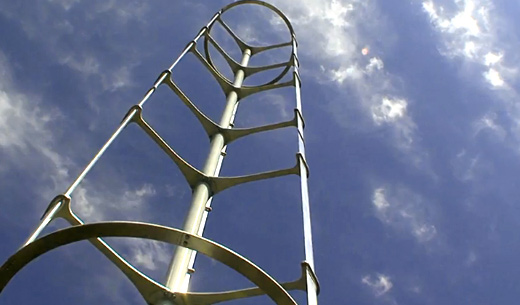
Since June, visitors to the Cincinnati Zoo have had a unique, but non-animal, attraction to see: the zoo's new, 30-foot vertical-axis wind turbine, or VAWT.
The turbine, is the first such unit installed at a zoo, and produces an estimated 2000 kilowatts of energy per year - enough to run a typical dishwasher and refrigerator for a year, according to the Zoo. The turbine and a series of solar panels are providing a third of the power needed to run the Zoo's ticketing building.
It's a nifty concept, and an aesthetically interesting one to boot: Rather than the propeller/windmill shape many have come to know as typical for wind turbines, the VAWT looks more like an elongated eggbeater blade, or some type of kinetic sculpture. Videos on the zoo's website show the aerodynamic blades turning slowly in this summer's light breezes, looking more like a child's mobile than an efficient generator.
And the videos show another side of the turbine, too. Comments on one, accessed through YouTube, harp on the zoo for spending a significant amount of money on a turbine that produces very little power (the actual cost of the turbine is not listed, but smaller residential units retail for roughly $4,000). In a sense, the comment has a point: why raise a turbine - in an area not known for consistent wind - that can only power a fraction of one building on a very large, very energy-costly campus? Is that really money well spent?
A little digging suggests two responses: first, it's not about electricity. Second, in that light it's money very well spent.
Visit the
Zoo's website and peruse its medial information about the turbine, and it's clear that the installation is less about producing energy than it is about education. There are videos describing the vertical axis design, and showing it at work. There are pdf brochures and pages of information about residential use of wind generators and solar arrays. There is coverage of the Zoo's efforts to save polar bears, whose habitats are at risk due to global warming. And pages throughout the site feature the phrase "what can I do to go green?"
The Zoo's turbine is about education. It's a unique eye-catcher, and a touchstone for Zoo media staff to use when connecting visitors to its other, more action- and results-oriented sustainability efforts. The Greenest Zoo in America may not have the most powerful, cost-effective wind turbine on the planet, from a purely numbers standpoint, but taken in larger context, it's a valuable player in a larger effort to produce sustainable, environmentally friendly change in Cincinnati.
Writer: Matt Cunningham
Images pulled from Cincinnati Zoo video.
Enjoy this story?
Sign up for free solutions-based reporting in your inbox each week.